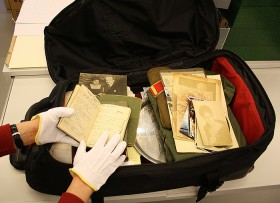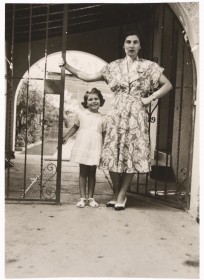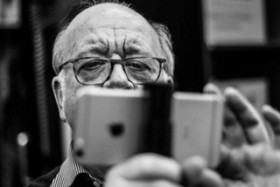A Guest Entry by Rudij Bergmann
Accompanying our current exhibition, “No Compromises! The Art of Boris Lurie,” Rudij Bergmann’s film about the artist will premiere on 21 March 2016 (additional information available on our event calendar). In this guest entry, the filmmaker tells us how this very personal documentary came about.
The artist’s longing for Europe was palpable from the moment I first saw him in the dim light of an apartment hallway on New York’s 66th Street. Stepping into his home studio, confronted by this breathtaking collage of memory, it was immediately clear to me that Boris Lurie hadn’t fully left the concentration camps he survived with his father – at least mentally.
It was October 1996. A film for the television magazine BERGMANNsART, which I’m for all intents and purposes responsible for, was the reason to rush to see Lurie in New York. (The film, in German and with age restriction, is available on YouTube.)
It was the beginning of a long friendship. → continue reading
The Last Signs of a Life in Germany Sold at Auction 75 Years Ago

Franziska Bogdanov, unpacking the suitcase from Arno Roland’s bequest
Jewish Museum Berlin CC-BY Katharina Erbe
The items in our archives have arrived here through the most various means: we have donations from German-Jewish emigrants from all over the world as well as gifts from their estates, donated to the museum after they have died by their children. We also receive some gifts from Germany, occasionally from people who aren’t themselves Jewish and yet some memorabilia from a Jewish friend or acquaintance was passed down through the generations in their family.
At the end of this last year we received a donation from the estate of a one-time Berliner who recently died in New Jersey (USA). It consisted of a large suitcase filled to the brim with documents, letters, photographs, and other objects. → continue reading
A Look at the Radzewski Family Photo Collection
We all have family: father, mother, children, grandchildren, grandparents, aunts, uncles, or just relatives casually come across at family reunions or known from photos. “The uncle, living abroad, with the daughter and the grandchildren – don’t you remember him?” We’ve all heard that.

The donor, Vera de Jong with her mother, Meta Krotoschiner in front of their home in Santiago, Chile, in 1952, following immigration © Jewish Museum Berlin, gift of Vera de Jong, née Krotoschiner-Radzewski
What happens when there’s no one to keep telling these stories? Only a photo of these people remain, if you’re lucky, sometimes a postcard that says nothing. This isn’t only the case in our private lives. As museum workers, we confront this challenge on a daily basis, especially when inventorying collections of donors’ family photographs. Each photo poses the same questions: Where was this? Who were these people – friends or relatives? What’s the story behind the image?
Fortunately we have help. Along with the photographs, donors provide and entrust us with their memories. Vera de Jong, born Krotoschiner-Radzewski, is one such example. Last year she gave our museum some 200 family photos (further information about the Photographic Collection on our website). As an academic trainee, it was then my task to inventory this collection and research its history. I was immediately taken by these charming images and, while researching them, understood their historical value, helping us uncover more than a century of family history. → continue reading


